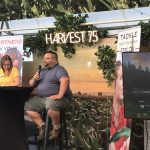Manitoba crops like flax, corn and sunflowers will get better research attention through a new agronomist in residence position at the University of Manitoba, according to the Manitoba Crop Alliance.
Tag Archives Agronomy

Special crops get new agronomist in residence at University of Manitoba
Loveleen Kaur Dhillon has been named the agronomist in residence for special crops at the University of Manitoba,a newly created five-year position supported by the Manitoba Crop Alliance

Agronomists give predictions at Canada’s Outdoor Farm Show 2024
Glacier FarmMedia — Experts and agronomists offered reflections on the 2024 growing season and predictions for 2025 at Canada’s Outdoor Farm Show Tuesday. Independent agronomist Aaron Breimer spoke to the curveballs and unpredictability of the past year and offered predictions and suggestions for farmers in the coming seasons. He was a guest speaker at the […] Read more

Canola counts on agronomy, future innovation
Sector is convinced that improved agronomy in the short term and big innovations in the 2030s will push yields higher
In early October, Western Producer reporter Robert Arnason spoke with Curtis Rempel, vice-president of crop production and innovation with the Canola Council of Canada. The topic was canola yield gains over the last two decades and what will drive gains in the future. RA: What happened in the 2000s, which led to significant yield increases […] Read more
An app for that: keeping track is key to keeping up in agronomy business or farm
Mapping and note-taking are the stock and trade for agrologists and large farms, but rapid record keeping can be onerous
LANGNHAM, Sask. — Sending agronomic reports to customers used to be an onerous task for Kara Annand, who is an owner of Ag Grow Consulting of Nipawin, Sask. So, the company hired a developer to build a cloud-based app called AgScouter to help its agronomists efficiently take and send in field reports to customers. “It’s […] Read more
Prairie soil after a fire
Risks
Some mainstream news outlets tend to sensationalize their coverage of prairie wildfires by emphasizing how many “acres of land were destroyed,” leaving Canadians with the impression that the land is gone. Grassland specialists such as Barry Adams counter those reports by explaining that fire cannot destroy land. “But it can destroy peoples lives,” said Adams, […] Read more
Ontario research aims to make canola profitable
Ontario growers now have a Canola Learning Centre to help them overcome some of the problems with growing profitable canola. Canola is the largest crop grown in Canada, overtaking wheat this year, but in Ontario acres have been decreasing. Canola acres have declined by about a third in the past five years to 40,000 acres. […] Read more

Use caution with pre-harvest applications
Saskatchewan’s provincial wheat commission is reminding farmers to follow label directions when applying desiccants or weed control products to standing crops this fall. It’s not a new message, says SaskWheat chair Bill Gehl, but it’s one that needs to be repeated to ensure producers are using the products correctly and not negatively affecting the quality […] Read more

Weevils threaten alfalfa crop
Prairie growers should be checking their alfalfa fields for alfalfa weevils as soon as possible, say forage experts in Manitoba and Saskatchewan. If weevil larvae numbers are high, the alfalfa crop should be cut immediately, weather permitting. If that’s not possible, growers should consider a pesticide application. “There are many alfalfa fields where if it’s […] Read more

Continuous canola not as profitable as farmers might think
LACOMBE, Alta. — A new Agriculture Canada study suggests tight canola rotations do not provide better returns than longer and more diverse rotations. “People say they have to grow continuous canola because they are getting the highest net returns,” Neil Harker, an Agriculture Canada research scientist said during a presentation at Murray Hartman’s ScienceOrama in […] Read more

Apps help identify invasive weeds
In March David Andrews, a cattle rancher from Irricana, Alta, took photos of an unusual weed on pastureland near his farm. Andrews suspected that the two-metre-tall weed was palmer amaranth, a weed found in most American states but not in Western Canada, yet. Weed experts in Alberta and Arkansas looked at the photos and concluded […] Read more



